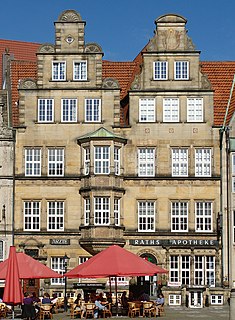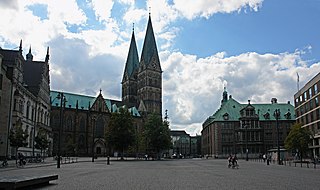
The Weser is a river of Lower Saxony in north-west Germany. It begins at Hannoversch Münden through the confluence of the Werra and Fulda. It passes through the Hanseatic city of Bremen. Its mouth is 50 km (31 mi) further north against the ports of Bremerhaven and Nordenham. The latter is on the Butjadingen Peninsula. It then merges into the North Sea via two highly saline, estuarine mouths.

Vegesack is a northern district of the city of Bremen.

The Kunsthalle Bremen is an art museum in Bremen, Germany. It is located close to the Bremen Old Town on the "Culture Mile". The Kunsthalle was built in 1849, enlarged in 1902 by architect Eduard Gildemeister, and expanded several more times, most notably in 2011. Since 1977, the building has been designated a Kulturdenkmal on Germany's buildings heritage list.

Bremen, officially the City Municipality of Bremen, is the capital of the German state Free Hanseatic City of Bremen, a two-city-state consisting of the cities of Bremen and Bremerhaven. With about 570,000 inhabitants, the Hanseatic city is the 11th largest city of Germany and the second largest city in Northern Germany after Hamburg.

The Bremen City Hall is the seat of the President of the Senate and Mayor of the Free Hanseatic City of Bremen. It is one of the most important examples of Brick Gothic and Weser Renaissance architecture in Europe. Since 1973, it has been a protected historical building. In July 2004, along with the Bremen Roland statue, the building was added to the list of UNESCO World Heritage Sites.

Schnoor is a neighbourhood in the medieval centre of the German city of Bremen, and the only part of it that has preserved a medieval character. The neighbourhood owes its name to old handicrafts associated with shipping. The alleys between the houses were often associated with occupations or objects: There was an area in which ropes and cables were produced and a neighboring area, where wire cables and anchor chains were manufactured.

Manor House Museum, Ilkley, England, is a local heritage museum and art gallery, and was established in the present building in 1961 to preserve local archaeological artefacts after the spa town expanded and much Roman material was lost. It was managed by Bradford Council Museums and Galleries department but unfortunately had to be closed in 2015 owing to lack of funds. A group of individuals who were passionate about keeping the building open for the public formed the Ilkley Manor House Trust and in April 2018 Bradford Council transferred the Manor House and 3 adjacent cottages to the Trust as a community asset transfer.

Weser Renaissance is a form of Northern Renaissance architectural style that is found in the area around the River Weser in central Germany and which has been well preserved in the towns and cities of the region.

The Balge was a short branch of the Weser on its eastern side, running through what is now the centre of Bremen. As it served as a harbour in the early Middle Ages, it significantly contributed to Bremen's development as a port. The river gradually narrowed until in 1608, it was canalised. In 1838, it was completely filled with earth.

The Raths-Apotheke is a listed building on the Market Square (Marktplatz) in Bremen, Germany. After suffering war damage, the building was restored with two gables in the Neobaroque style in 1958, re-establishing the square's sequence of gabled buildings dating from the 1820s.

Wilhelm Wagenfeld House is a design museum and exhibition centre in Bremen, Germany. Completed in the Neoclassical style in 1828, the building now carries the name of Bremen-born Wilhelm Wagenfeld (1900–1990), a major contributor to the 20th-century design of household objects. In addition to a collection of Wagenfeld's creations, the building hosts temporary design exhibitions. It is located in Bremen's Old Town (Altstadt) close to the Kunsthalle Bremen art museum.

The Domshof is a town square in Bremen, north of the cathedral and the Marktplatz. The Domshof is used for markets as well as larger outdoor events, particularly May Day demonstrations.

The Marterburg is a street in the Schnoor district of Bremen in the north of Germany. The name comes from Mattenburg as it was the place where the millers used to store flour in Matten (silos). The street runs from Ostertorstraße in a southwesterly direction curving slightly westwards before reaching the Tiefer near the river. Sidestreets include Kolpingstraße, Hinter der Balge and Schnoor. The street follows the old city wall which forms the rear of the houses on the eastern side, sometimes being used as part of their foundations. Many of the buildings to the south of Kolpingstraße are old listed buildings, several of which have been restored.

The Landherrnamt is a building in the Schnoor district of Bremen, Germany, which was designed by Alexander Schröder in the Neo-Romanesque style and completed in 1856.

The Suding & Soeken building is a gabled house at No. 28 Langenstraße in Bremen, Germany. Referred to as a Kaufmannshaus or Kontorhaus, it is one of the city's few historic merchant houses to survive the war undamaged. It is noted for its projecting Renaissance bay window and its two-tiered Baroque stairway ascending from the hallway.

St Catherine's Monastery in Bremen, Germany, was founded in 1253 by the Dominicans. Today traces of its existence remain in the area of the Katharinenstraße and Katharinenklosterhof in the old town.

Robinson Crusoe House is a stepped-gabled house on Böttcherstraße in the old town district of Bremen, Germany. It was built by the prosperous coffee merchant Ludwig Roselius who admired the pioneering spirit of Daniel Defoe's fictional hero Robinson Crusoe.

The Ports of Bremen, Bremen Ports or Bremish Ports, in German "Bremische Häfen" consist of the commercial ports in Bremen and Bremerhaven. They are managed by bremenports GmbH & Co. KG, a company of private status in public property.

The Focke Museum is the museum of history and the history of art for the city and state of Bremen. It was formed in 1924 by the merger of a museum of industry and commerce and the previous historical museum, and is named for the founder of the latter, Johann Focke (1848–1922), a Bremen privy councillor and father of Henrich Focke. It is located in 4.5 hectares of grounds in the Riensberg neighbourhood of the city. In addition to a main building which opened in 1964 and was extended in 2002, the museum complex includes buildings dating from the 16th to the 19th centuries.

The Nordwolle or more correctly the Nordwolle museum or the Nordwestdeutsche Museum für IndustrieKultur is situated in and around the engine house of the former Norddeutsche Wollkämmerei & Kammgarnspinnerei in Delmenhorst. Nordwolle was a dominant company that processed wool and worsted, it closed between 1981 and 1984. The building and the factory housing is listed as a Denkmalschutz The museum is an Anchor point on the European Route of Industrial Heritage.























